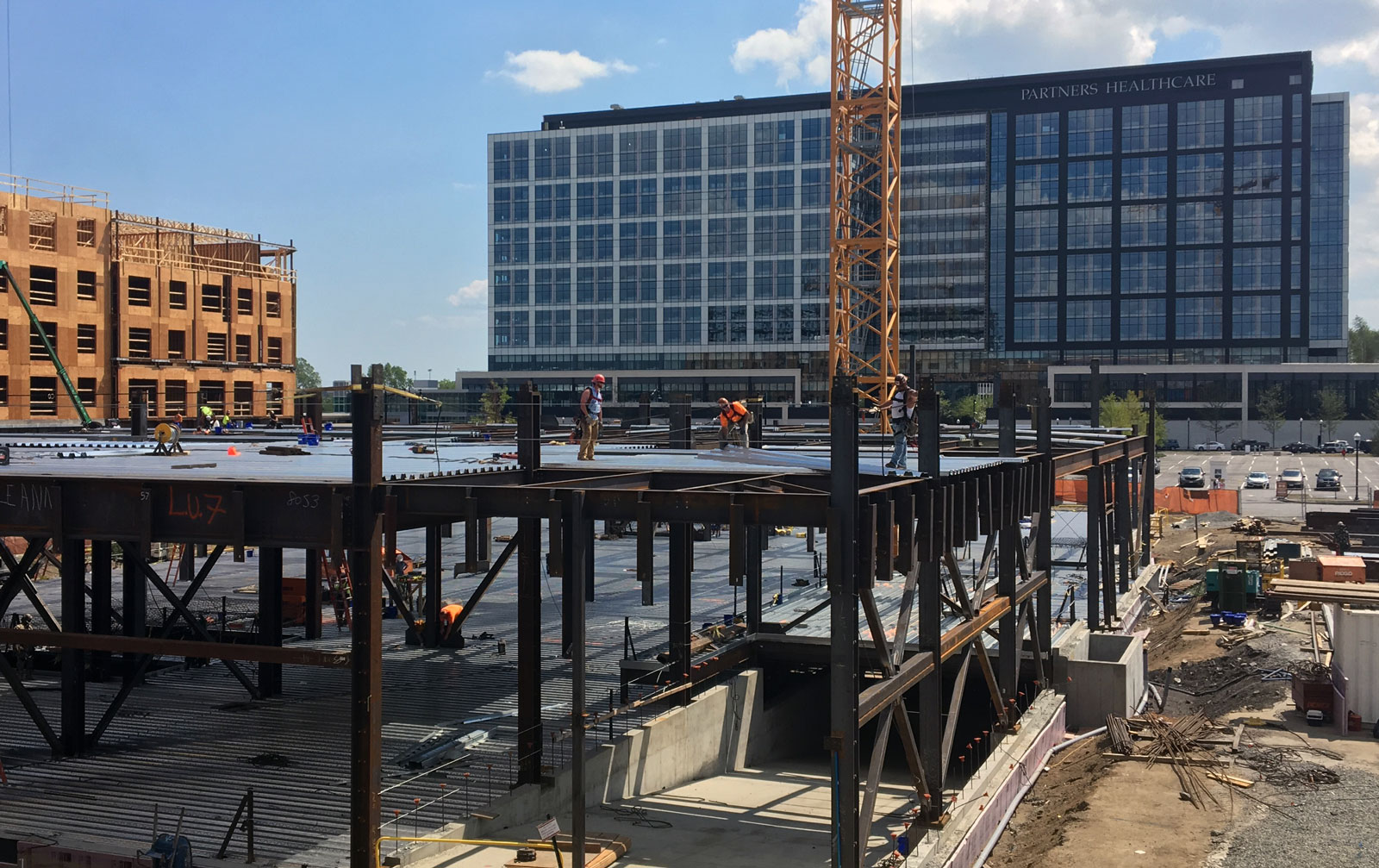After more than a year of engagement, research, and analysis, the City of Somerville published Somerville’s first-ever citywide Bicycle Network Plan in April 2023 and the City Council voted to approve the plan on September 28, 2023! Thank you to all the hundreds of community members that provided invaluable feedback throughout this process.
The Plan documents Somerville’s community-based vision for an 88-mile network of connected streets and paths where people of all ages and abilities will be able to bike safely and comfortably. The Bicycle Network Plan envisions a future with vastly more biking infrastructure and better connectivity so that residents, workers, and visitors can bike to schools, parks, jobs, businesses, and other key destinations in Somerville and across the region. Learn more about the plan below. To learn more about the development of plan from 2021 to 2023, visit the City’s SomerVoice webpage.
Jump To:
The Bicycle Network Plan includes the following components:
- The Full Plan
- Executive Summary: Available in English, Spanish, Portuguese, Nepali, Haitian Creole, Traditional Chinese, and Simplified Chinese
- Mayor's Letter, Acknowledgements and Table of Contents
- Chapter 0: Introduction
- Chapter 1: Bicycle Plan Goals
- Chapter 2: Bicycling in Somerville Today
- Chapter 3: Community Engagement
- Chapter 4: Network Vision
- Chapter 5: Implementation
- Appendices (A, A1, A2, A3, A4, A5, A6, A7, B, C)
Key Figures in the Plan
- Bicycle Network Vision Map – 20 Year Projection.
- Priority Network Vision Map – Network to be completed by 2030.
What are the Somerville Bicycle Network Plan Goals?
Shifting travel away from single-occupancy vehicles and toward sustainable modes like biking is essential to meet the City’s Vision Zero public safety goals, Somerville Climate Forward goals, and SomerVision comprehensive planning goals. The Bicycle Network Plan goals reflect and reinforce these Citywide planning objectives:
- Goal #1 – Increase biking as the main mode of transportation for daily trips and aim for 15% of residents traveling by bike by 2050.
- Goal #2 - Provide infrastructure throughout Somerville that is safe and comfortable for biking for all residents regardless of age, ability, gender, and background.
- Goal #3 - Ensure that every resident in Somerville has access to a bicycle and can safely reach their everyday destinations by biking.
What are the proposed bicycle facilities?
The network offers a connected set of streets and paths with one of the following facilities. Each facility will be designed to be safe and comfortable for users of any biking ability.
What is the proposed network?
The proposed network represents a vision for a web of streets with safe bicycle facilities. The selection of streets and facilities was created by considering the importance of
- having protected bicycle lanes on higher volume and higher speed roads while still maintaining parking on at least one side of the street,
- offering alternative safe and low stress residential routes, if possible,
- accommodating current or proposed bus service,
- providing plentiful north-south and east-west bike routes to ensure connections to schools, parks, and commercial centers.
 |
|
Bicycle Network Plan Vision Map. The proposed citywide network takes Somerville’s bicycle network from 30.1 miles to a total of 88.1 miles, an increase of 58 miles. |
For full details, read Chapter 4 of the Bicycle Network Plan.
When will the plan be implemented?
The Plan identifies priority streets for protected bike lanes and Neighborways based on a set of criteria that focuses on equity, connectivity, access to destinations, topography, and safety. The goal is to implement quick-build designs with tools like paint, flexible posts, and signage, for the priority streets by 2030. Quick-Build designs allow staff to evaluate changes and adjust for more permanent long-term designs. Once a street is selected for quick-build or permanent implementation, City staff will launch a street-specific public engagement and design process, which will include traffic data collection and parking analysis.
 |
|
Priority Network Map of streets to be completed by 2030. |
For full details, read Chapter 5 of the Bicycle Network Plan.
Status of the Plan
Since publishing the Plan in 2023, the City has been working to implement the Network Vision with particular focus on installing the Priority Network.
Priority Bicycle Network Status

In 2024, we installed 1.33 protected bicycle lane miles. Protected bicycle lane miles capture the length of new facilities in one direction. If we implement two-way facilities on a length of street that is approximately 0.5 miles long, this would be approximately 1 mile of protected bicycle lane miles. In 2025, we aim to install 3.28 protected bicycle lane miles. By the end of 2025, we anticipate having 14.5, or 65%, left to complete through the end of 2030.
In 2024, we also implemented 0.76 new Neighborways street miles and will add 0.2 miles in 2025. We have approximately 91% more to complete between the end of 2025 and 2030 to complete the Priority Network.
2024 Implemented Priority Network Protected Bicycle Lanes
| Street | From | To | Priority Miles |
| Broadway | Boston Ave | Broadway Bridge | 0.11 |
| Foley St | Middlesex Ave | Grand Union Blvd | 0.09 |
| Highland Ave | Davis Sq | Davis Sq | 0.01 |
| Somerville Ave | #599 | #599 | 0.04 |
| Somerville Ave | Prospect St | Milk Alley | 0.04 |
| Washington St | Line St | Webster Ave/ Somerville Ave | 1.04 |
|
|
1.33 | ||
Some of these new facilities include sidewalk and street-level protected bicycle lanes constructed as part of the Western Washington Mobility Improvements Project. Shorter segments of new facilities were also installed as part of new developments on Somerville Avenue.
2024 Implemented Priority Network Neighborway Streets
| Street | From | To | Priority Miles |
| Walnut | Community Path | Gilman Street | 0.03 |
| Glen Street | Tufts Street | Broadway | 0.49 |
| Otis Street | McGrath | Cross Street | 0.15 |
| Ellsworth Street | Cross Street | Rush Street | 0.05 |
| Rush Street | Ellsworth Street | East Somerville Community School | 0.02 |
| Parking Lot | Rush Street | Glen Street | 0.05 |
|
|
0.76 | ||
In 2024, we installed new Neighborways facilities as part of the Glen & Otis Street Quick-Build Neighborway project creating new East Somerville connections to the Capuano Early Childhood Center, the East Somerville Community School, and the Winter Hill at Edgerley School.
2025 Planned Priority Network Protected Bicycle Lanes
| Street | From | To | Priority Miles |
| Central St | Summer St | Highland Ave | 0.23 |
| Curtis St | Broadway | Electric Ave | 0.08 |
| McGrath Hwy | Rufo Rd | Broadway | 2.37 |
| Medford St / McGrath Hwy Ramp | Prospect Hill Ave | Somerville Ave | 0.13 |
| Medford St / McGrath Hwy Frontage | Poplar St | Linwood St | 0.32 |
| Somerville Ave | Park St | Beech St | 0.12 |
| Washington St | #210 | #215 | 0.03 |
|
|
3.28 | ||
In 2025, we anticipate over 3 miles of new protected bicycle lanes with the majority of new facilities coming as part of the McGrath Highway Resurfacing project. New two-way sidewalk level protected bike lanes will be completed on Central Street between Summer Street and Highland Avenue as part of the Spring Hill Sewer Separation project.
2025 Planned Priority Network Neighborways
| Street | From | To | Priority Miles |
| Tufts Street | Cross Street | Washington Street | 0.20 |
|
|
0.20 | ||
We also aim to construct a new Neighborway through the Tufts Street Reconstruction project that includes expanded sidewalks, new tree plantings and traffic calming features like street pinch points.
In the next few years, we aim to install new permanent and quick-build bicycle lanes through projects like the West Broadway Reconstruction, the Elm-Beacon Connector Quick-Build, and the Western Pearl Reconstruction, and more. We will continue to update this page with new information after we have launched new projects.
In addition, we aimed to publish support guides to the Plan following the publishing of the full Plan in 2023. This included the Bicycle Design, Wayfinding Guide, Operations/Maintenance Guide, Bicycle Parking Guide by end of 2023, and the Community Engagement Guide, Evaluation Guide, and Education Guide by the end of 2024. We are delayed in completing these guides as we wanted to take more time, and we have been more focused on mobilizing implementation efforts. Regarding the Bicycle Design Guide, we are excited to learn from and where appropriate refer to information and standards in the recently published National Association of City Transportation Officials Urban Bikeway Design Guide for our City of Somerville specific guidelines.
If you are interested in a more detailed breakout for priority protected bicycle implementation, please check out the City of Somerville’s Report to City Council on the Safe Streets Ordinances for February 2025.
If you have any questions, please reach out to the Mobility Division at transportation@somervillema.gov.
Programs & Initiatives
Feedback
Please submit website feedback using this form. Be sure to include:
Thank you for your feedback!







